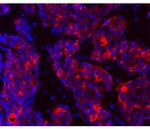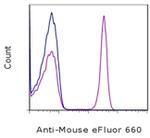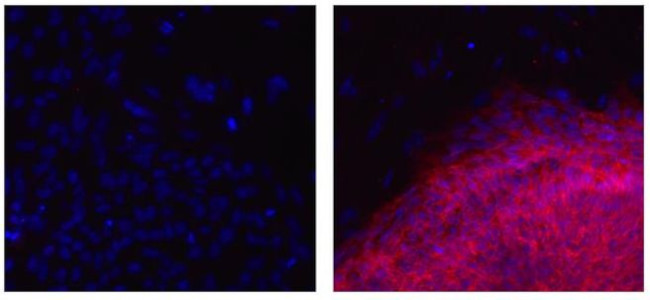Search Thermo Fisher Scientific
Invitrogen
F(ab')2-Goat anti-Mouse IgG (H+L) Secondary Antibody, eFluor™ 660, eBioscience™
FIGURE: 1 / 5
Mouse IgG (H+L) Secondary Antibody (50-4010-82) in ICC/IF





Product Details
50-4010-82
Immunohistochemistry (Paraffin) (IHC (P))
Immunocytochemistry (ICC/IF)
Flow Cytometry (Flow)
Species Reactivity
Host/Isotype
Class
Type
Conjugate
Excitation/Emission Max
Form
Concentration
Purification
Storage buffer
Contains
Storage conditions
Shipping conditions
RRID
Target
Antibody Form
Product Specific Information
Description: The goat anti-mouse IgG polyclonal antibody reacts with the heavy and light chains of mouse IgG, with minimal cross reactivity to human, rat, bovine, goat, hamster, and rabbit serum proteins. Reactivity has been shown to IgG1, IgG2a, IgG2b, and IgG3, as well as some reactivity to IgM. The antibody is a F(ab')2 fragment which contains the 2 Fab domains still linked through the hinge region of the immunoglobulin. Removal of the Fc region helps to reduce issues typically found with Fc-mediated binding.
This polyclonal has been validated as a secondary reagent (its ability to recognize cells stained with a mouse IgG followed by this polyclonal antibody).
Applications Reported: This polyclonal antibody has been reported for use in flow cytometric analysis, immunohistochemistry and immunocytochemistry.
Applications Tested: This polyclonal antibody has been tested by flow cytometric analysis of normal human peripheral blood cells stained first with a mouse anti-human antibody. This can be used at less than or equal to 0.5 µg per test. A test is defined as the amount (µg) of antibody that will stain a cell sample in a final volume of 100 µL. Cell number should be determined empirically but can range from 10^5 to 10^8 cells/test. This polyclonal antibody has been tested by immunohistochemistry on formalin-fixed paraffin embedded sections that have been stained first with a mouse anti-human antibody. This can be used at less than or equal to 10 µg/mL. It is recommended that the antibody be carefully titrated for optimal performance in the assay of interest.
eFluor® 660 is a replacement for Alexa Fluor® 647. eFluor® 660 emits at 659 nm and is excited with the red laser (633 nm). Please make sure that your instrument is capable of detecting this fluorochome.
Excitation: 633-647 nm; Emission: 668 nm; Laser: Red Laser.
Filtration: 0.2 µm post-manufacturing filtered.
Target Information
Anti-Mouse secondary antibodies are affinity-purified antibodies with well-characterized specificity for mouse immunoglobulins and are useful in the detection, sorting or purification of its specified target. Secondary antibodies offer increased versatility enabling users to use many detection systems (e.g. HRP, AP, fluorescence). They can also provide greater sensitivity through signal amplification as multiple secondary antibodies can bind to a single primary antibody. Most commonly, secondary antibodies are generated by immunizing the host animal with a pooled population of immunoglobulins from the target species and can be further purified and modified (i.e. immunoaffinity chromatography, antibody fragmentation, label conjugation, etc.) to generate highly specific reagents.
For Research Use Only. Not for use in diagnostic procedures. Not for resale without express authorization.

Performance Guarantee
If an Invitrogen™ antibody doesn't perform as described on our website or datasheet,we'll replace the product at no cost to you, or provide you with a credit for a future purchase.*
Learn more
We're here to help
Get expert recommendations for common problems or connect directly with an on staff expert for technical assistance related to applications, equipment and general product use.
Contact tech support

